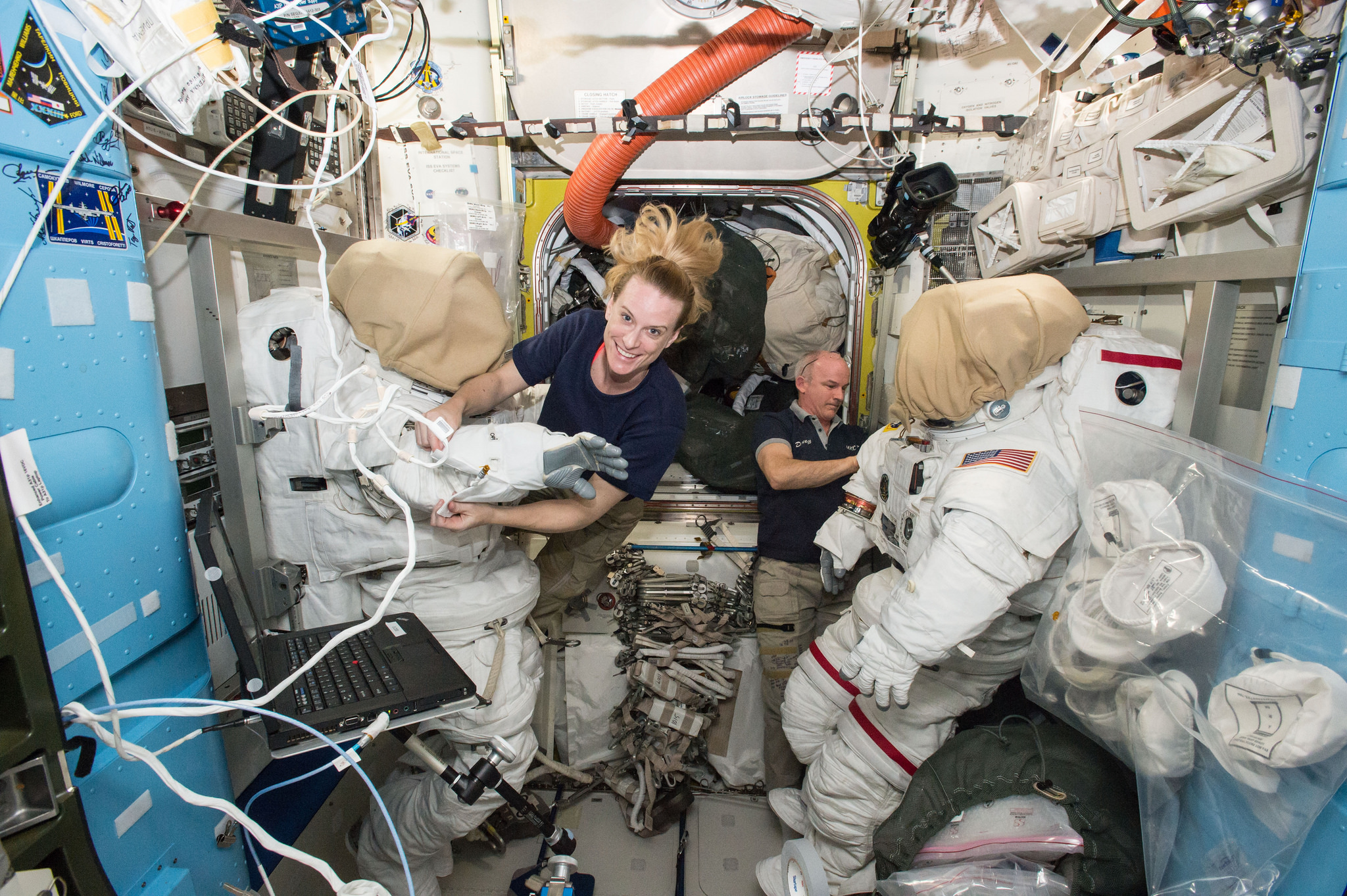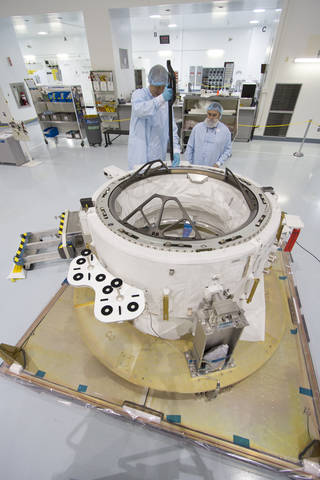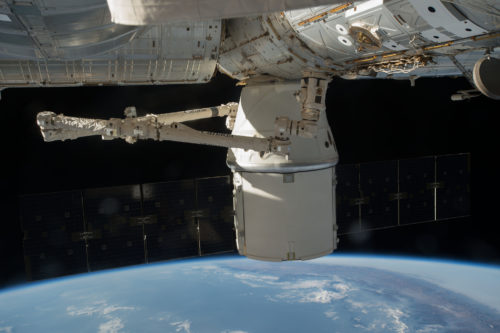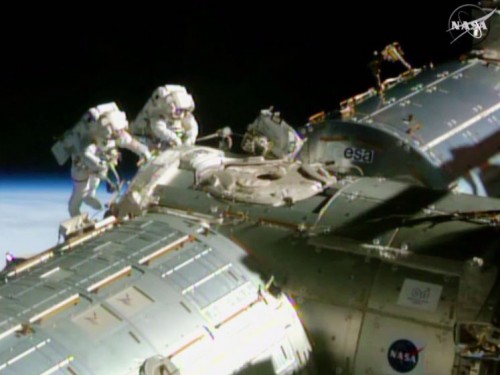
Expedition 48 Commander Jeff Williams and Flight Engineer Kate Rubins work with their Extravehicular Mobility Unit (EMU) suits in the Quest airlock. Photo Credit: NASA
Expedition 48 Commander Jeff Williams and Flight Engineer Kate Rubins will venture outside the International Space Station (ISS) on Friday, 19 August, to install the first of two Boeing-built International Docking Adapters (IDA-2) onto the orbital outpost. These mechanisms will be attached to the forward and space-facing (or “zenith”) sides of the Harmony node and will provide critical primary and backup docking interfaces for NASA’s two Commercial Crew providers: Boeing’s CST-100 Starliner and SpaceX’s Crew Dragon from fall 2017 onwards. In readiness for the upcoming EVA-36, mission controllers will robotically remove IDA-2 from the unpressurized “trunk” on Wednesday and position it close to Pressurized Mating Adapter (PMA)-2 on the forward end of Harmony. This will allow Williams and Rubins to install what has been described as the space station’s “gateway” for Commercial Crew operations.
Friday’s spacewalk is designated “U.S. EVA-36” and marks the 36th excursion performed outside the space station, in U.S.-built Extravehicular Mobility Units (EMUs), and conducted without the presence of an attendant Space Shuttle. Since U.S. EVA-1, way back in February 2002, these “Stage” EVAs have played a critical role in preparing the ISS for future expansion, as well as removing and replacing a failed ammonia pump module and a Main Bus Switching Unit (MBSU) and tending to ammonia leakages and the deterioration of several pieces of hardware. EVA-36 was described by ISS Operations Integration Manager Kenny Todd as a “very significant milestone”, in that the addition of IDA-2 will permit the first Commercial Crew vehicles to visit the station in an unpiloted and later crewed capacity at some stage in the fall of 2017 and into the spring of 2018.

The second International Docking Adapter (IDA-2) will provide the primary docking interface for Commercial Crew. The adapter was built to the specifications of the International Docking Standards, and it will be a connection point for commercial crew spacecraft visiting the orbiting laboratory.
Photo Credit: NASA/Cory Huston
However, EVA-36 comes seven months after Expedition 46 astronauts Tim Kopra and Britain’s Tim Peake were forced to return early to the station’s Quest airlock during EVA-35 on 15 January. The premature end to their spacewalk came when Kopra noticed water bubbles in his helmet, which generated unpleasant reminders of the life-threatening experience of Italian astronaut Luca Parmitano in July 2013. Mr. Todd explained that “a good amount of success” had been attained, working through various legs of the fault-tree, to reach agreement on the probable cause for the EVA-35 incident. Unlike 2013, when the capability to return the EMU to the ground in a timely manner was not possible, the situation in 2016 allowed the suit to be brought back to Earth and examined from a fully integrated standpoint, with a person inside. It also offered the opportunity to tear down the suit’s components, but the problem seen on-orbit could not be easily replicated.
In fact, all EMU components passed and were classified within specification under test. The only off-nominal discovery, according to Mr. Todd, was a second set of “holes” in the sublimator, which is responsible for managing condensation in the suit. During the investigation process, evidence of a condensation blockage was detected and although the sublimator itself performed as expected during component-level tests, it remained unclear how the hardware might behave in the microgravity environment.
As to the specific cause of the moisture in Kopra’s suit during EVA-35, Mr. Todd highlighted a couple of procedural issues which might have played into the situation. One possibility is that suits are generally primed on the hotter side, shortly after their wearers depart the Quest airlock, in order to generate moisture and allow the CO2 scrubbers to get up and running and allow the EVA to progress to its full length. Taking into account variables such as the spacewalkers’ metabolic rates, it seemed that the team was “overachieving” in terms of moisture-generation at the start of EVA-35. Another facet was the decision in the last couple of EVAs to switch the suit’s temp cold valve to its full-cold setting, thereby changing temperatures rapidly across the EMU. Coupled with moisture, this would create correspondingly greater levels of condensation in the suit.
The tasks of EVA-36 have been in work for around two years, according to Lead Spacewalk Officer Glenda Brown. Original plans called for two International Docking Adapters—designated IDA-1 and IDA-2—to be installed onto the space station, with the former fulfilling a primary role at the “forward” end of the Harmony node and the latter providing backup capability on its space-facing (or “zenith”) side. All that changed on 28 June 2015, when IDA-1 was lost during a launch vehicle failure as it rose to orbit aboard SpaceX’s CRS-7 Dragon cargo ship. In the weeks and months which followed, IDA-2 was pressed into service as the replacement “primary” docking port, with another backup (IDA-3) currently in the process of being fabricated from structural and other spares. A specific launch date for IDA-3 has yet to be determined, although Ms. Brown noted that it will occur sometime late in 2017. However, Mr. Todd later added that a 2018 target for the launch of IDA-3 was more likely, but that the early flights of CST-100 Starliner and Crew Dragon could be performed with just one IDA in place.
More than a year after the loss of IDA-1, its near-twin successfully launched aboard SpaceX’s CRS-9 Dragon on 18 July and reached the ISS two days later. Secured inside Dragon’s unpressurized “trunk”, IDA-2 spent its first month in-situ, but is expected to be robotically removed—by means of the space station’s 57.7-foot-long (17.6-meter) Canadarm2 robotic arm and Dextre “hand”—on Wednesday, 17 August. At the controls of the “Big Arm” will be Robotics Officer (ROBO) David Gruntz, seated at his console in the Mission Control Center (MCC) at the Johnson Space Center (JSC) in Houston, Texas.

IDA-2 arrived in July 2016, aboard SpaceX’s CRS-9 Dragon cargo vehicle. Photo Credit: NASA
Mr. Gruntz will initially position IDA-2 on the end of Dextre about 3 feet (90 cm) from PMA-2, where it will remain for a couple of nights. Then, as Williams and Rubins don their space suits in the Quest airlock on Friday morning, Mr. Gruntz will bring it closer to its target. This is expected to be the first time that a spacewalking crew will have direct physical interaction with Dextre during an EVA.
Although it is the 36th U.S. Stage spacewalk, EVA-36 is joined by dozens of shuttle-based and Russian Orbital Segment (ROS) excursions since December 1998. In fact, it is the 194th EVA conducted in support of the construction and maintenance of the sprawling international outpost. Leading EVA-36 will be Jeff Williams, who has accrued 19 hours and nine minutes of spacewalking experience during three EVAs from the shuttle and the ISS in both U.S. and Russian suits.
Significantly, when he ventures outside on Friday, Williams will become the United States’ oldest spacewalker. Aged 58 years and 214 days, he will neatly surpass Hubble Space Telescope (HST) repairman Story Musgrave by about 102 days. However, Williams will fall more than a year shy of the world’s oldest spacewalker. That title is currently held by Russia’s Pavel Vinogradov, who was four months short of his 60th birthday when he performed an EVA during Expedition 35 in April 2013. As for Kate Rubins, this will be her first career spacewalk, although she has trained extensively for her tasks and was intimately involved in the plans for how cables would be routed to the IDA installation worksites. She will be only the 12th female spacewalker in history, blazing a trail which was begun by Soviet cosmonaut Svetlana Savitskaya in July 1984.
Kicking off Friday’s activities, Williams (designated “EV1”, with red stripes on the legs of his suit for identification) and Rubins (“EV2”, clad in a pure white ensemble) will undertake 60 minutes of pre-breathing on masks, during which time the inner “equipment lock” of the Quest airlockwill be depressed from its ambient 14.7 psi to 10.2 psi. Assisted by Expedition 48 Flight Engineer Takuya Onishi, they win don and purge their EMUs and the airlock’s atmosphere will be repressurized back up to 14.7 psi. This will enable the spacewalkers to begin a nominal pre-breathing regime, lasting about 50 minutes, followed by another 50 minutes of In-Suit Light Exercise (ISLE). The latter was first trialed during the third EVA of the STS-134 shuttle mission in May 2011 and serves to rapidly remove nitrogen from the spacewalkers’ bloodstreams, thereby avoiding a potentially fatal attack of the “bends” and skirting the need for the EVA crew to “camp out” overnight in Quest.
Current plans call for EVA-36 to begin at about 8:10 a.m. EDT. Williams will exit the outer hatch of Quest, followed by Rubins, who will pass him an Orbital Replacement Unit (ORU) bag with the IDA tools. Ten years since his most recent EVA, Williams will translate along the starboard side of External Stowage Platform (ESP)-2, whilst Rubins collects her foot restraint, and both spacewalkers will translate over the Destiny lab and the Harmony node to reach Pressurized Mating Adapter (PMA)-2 at its forward end. Unused for a spacecraft docking since the end of the Space Shuttle era, PMA-2 was the site for intensive EVA activity last year, as Expedition 42’s Barry “Butch” Wilmore and Terry Virts and Expedition 46’s Scott Kelly and Tim Kopra labored to install and tie-off power and other cables for the IDAs.

Expedition 42 spacewalkers Barry “Butch” Wilmore and Terry Virts began laying IDA cables in February 2015. Photo Credit: NASA
Williams and Rubins will arrive at PMA-2 close to the positions at which they will be installing their cables: Rubins at its Earth-facing (or “nadir”) side, Williams slightly port and zenith. Having collected his own foot restraint from the Columbus lab, Williams will set to work with Rubins to attach Adjustable Equipment Tethers loosely to IDA-2. When they are ready, the duo will give ROBO the “Go” to release the new docking adapter and set to work mating heater power, drive and sensor power cables. Inside Harmony, Takuya Onishi—working at the IDA Control Panel—will operate switches to command hooks to extend, rotate and engage passive counterparts on PMA-2. Described as a “co-ordinated interplay” between Mission Control and Expedition 48 crew members inside and outside the space station, the task will be overseen from Houston by Capcom Tom Marshburn.
Assuming EVA-36 runs to its 6.5-hour timeline, Rubins will return inside the ISS as the tenth most seasoned woman spacewalker—having surpassed Savitskaya and America’s first female spacewalker, Kathy Sullivan—whilst Williams will advance from 93rd place on the world list of 215 EVA veterans to just inside the Top 60.
However, the movement of Orbital ATK’s OA-5 Cygnus cargo mission from 22 August to no sooner than late September has allowed the ISS Program to insert another U.S. EVA on 1 September. The primary objective of EVA-37 is the retraction of the Trailing Thermal Control Radiator (TTCR, nicknamed “the ticker”). The latter is an accordion-like piece of hardware, deployed by Expedition 33 astronauts Suni Williams and Aki Hoshide in November 2012, to provide cooling after the isolation of the troublesome Channel 2B Photovoltaic Radiator (PVR). Three years later, in November 2015, Expedition 46 astronauts Scott Kelly and Kjell Lindgren retracted the TTCR, but did not have time to cinch it down and install a protective cover. As a result, it was decided to simply redeploy the TTCR and lock it into place in a dormant state. On EVA-36, Williams and Rubins will retract the TTCR for good, as well as tending to several additional external tasks.
Quelle: AmericaSpace
-
Update: 18.08.2016
.

Quelle: NASA
-
Update: 19.08.2016
.
Spacewalk LIVE -NASA-TV-Frams:



...







...








...






...






...








...









...





...




...






...





(Reflexioneffekt über der Erde, für alle Pünktchensucher...)
...








...






...






...


